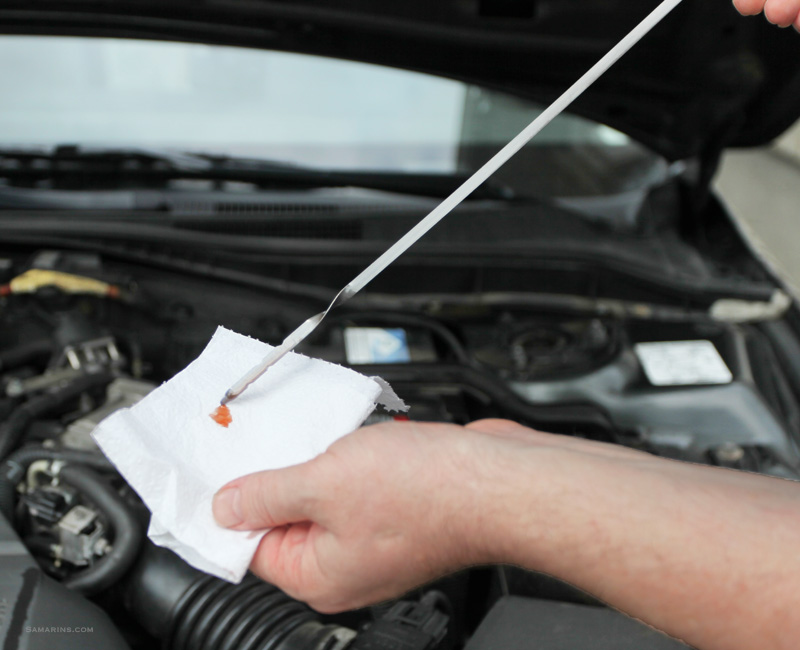Testing transmission fluid is crucial for maintaining your vehicle’s health. It helps ensure smooth gear shifts and prevents costly repairs.
Transmission fluid lubricates and cools the components of your transmission system. Over time, this fluid can degrade, leading to performance issues. Testing the fluid can help you determine its condition and decide if it needs replacing. In this guide, we’ll walk you through the steps to check your transmission fluid.
Whether you’re a seasoned car enthusiast or a beginner, understanding this process is essential. Let’s dive in and learn how to keep your transmission in top shape!
Introduction To Transmission Fluid Testing
Transmission fluid keeps your car running smoothly. It’s vital for the health of your vehicle. Testing the fluid ensures your car performs well. Regular checks can save you from costly repairs.
This fluid cools and lubricates the moving parts. It prevents overheating and reduces friction. Clean fluid ensures the transmission works properly. Dirty or low fluid can damage the transmission. Keeping it in good condition is essential.
Shifting gears becomes hard. You might hear strange noises. The car might jerk or hesitate. There could be a burning smell. The transmission might slip. These are signs of trouble.
Preparing For The Test
Before testing, collect all needed tools. You will need a clean rag, gloves, and a transmission fluid dipstick. Also, have a drip pan ready. These items help you check fluid easily.
Always wear gloves to protect your hands. Use a drip pan to catch spills. Turn off the engine before you start. Ensure the car is on level ground. This helps get an accurate fluid reading. Always be careful when working near engine parts.
Locating The Transmission Dipstick
Your vehicle manual is the best place to start. It contains specific details about your car. Look for the section on transmission fluid.
The dipstick is often located near the engine. It usually has a bright handle. This makes it easy to find. Once located, pull it out. Wipe it clean with a cloth.
Checking Fluid Level
Ensure the car is on level ground. Locate the transmission dipstick, remove it, and wipe it clean. Reinsert and pull it out to check the fluid level.
Warm Up The Engine
Start your car and let it run for a few minutes. This will warm up the engine. Warm fluid gives a more accurate reading.
Remove And Clean The Dipstick
Find the dipstick under the hood. Pull it out slowly. Use a clean cloth to wipe it off. Removing dirt and old fluid helps.
Reinsert And Check Fluid Level
Put the dipstick back into the tube. Pull it out again to check the fluid level. The fluid should be between two marks on the stick. If low, add more fluid.
Assessing Fluid Condition
Good transmission fluid is bright red or pink. Dark fluid might be bad. Brown or black fluid is a sign of trouble. Fresh fluid should be clear. Cloudy fluid needs to be changed.
Healthy fluid has no strong smell. Burnt odor means overheating. Sweet smell is normal. Sour or rancid smell is bad. Check for unusual odors.
Check fluid for dirt. Look for metal shavings. Contaminants can harm the transmission. Clean fluid is crucial. Dirty fluid needs replacement.

Credit: www.dummies.com
Refilling Or Replacing Fluid
Pick the fluid that matches your car’s needs. Check your car manual. Some cars need specific types of fluid. Using the wrong fluid can harm your car. Ask a mechanic if unsure.
First, locate the transmission dipstick. Pull it out. Wipe it clean. Put it back in. Pull it out again. Check the fluid level. Add fluid if needed. Use a funnel to avoid spills. Pour slowly. Check the level again. Do not overfill. Close the dipstick.
Replace fluid every 30,000 to 60,000 miles. Check your car manual for exact intervals. Dark or dirty fluid needs replacing. Burning smell means it’s time to change. Regular checks keep your car running well.
Post-test Procedures
After testing transmission fluid, check the fluid level again. Dispose of old fluid properly. Clean all tools used.
Cleaning Up
After testing the transmission fluid, gather your tools. Wipe them with a clean, dry cloth. Dispose of any used paper towels or rags safely. Check your hands for any fluid spills. Wash with soap and water if needed. Ensure no fluid is left on the ground. Wipe the area where you worked. This prevents any slips or falls.
Documenting Results
Write down your findings immediately. Note the fluid color. Record any unusual smells. Mention if the fluid was low or dirty. This helps in future checks. Keep a log of each test. This makes it easy to track changes. Reviewing past results can help identify issues early. Always store your notes in a safe place.

Credit: www.youtube.com
Common Mistakes To Avoid
Always warm up your car before checking the transmission fluid. Cold fluid gives incorrect readings. Run the engine for about 10 minutes. This ensures accurate results. Don’t skip this step.
Use the correct fluid type. Different cars need different fluids. Check your manual. Using the wrong fluid can damage your transmission. Always double-check before adding fluid.
Safety is key. Always park your car on a flat surface. Use the parking brake. Wear gloves to protect your hands. Never touch hot engine parts. Stay safe while checking the fluid.

Credit: www.autotransmatic.com
Conclusion
Testing transmission fluid is simple and crucial for your car’s health. Regular checks prevent major issues down the road. Follow the steps outlined to keep your transmission running smoothly. Remember, maintaining fluid levels and quality extends your vehicle’s life. Always consult your car’s manual for specific advice.
Regular maintenance saves money and stress. Keep an eye on your transmission fluid, and drive with confidence.
